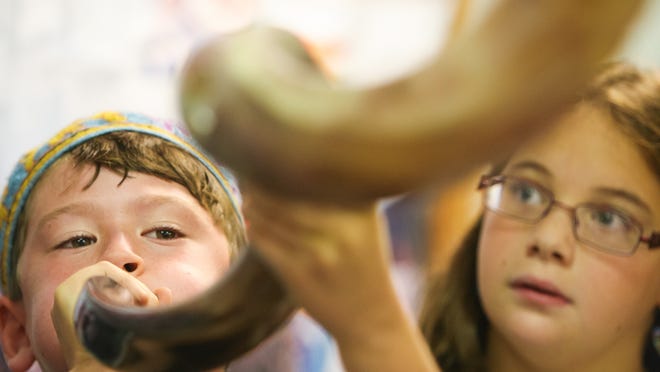Now that Rosh Hashanah has passed, the next Jewish holy holiday is Yom Kippur.
Here’s a glance at all things related to the holiday:
What is Yom Kippur?

Yom Kippur, also known as the Day of Atonement, marks the end of the Days of Awe, a 10-day period of introspection and repentance (teshuvah) that begins with Rosh Hashanah.
The holiday is considered Judaism’s most sacred day of the year, sometimes referred to as the “Sabbath of Sabbaths,” and is when Jews are closest to God and to the essence of their souls, according to History.
When is Yom Kippur?
Yom Kippur is observed on the 10th day of tishrei, the seventh month of the Hebrew calendar. This year, the holiday begins at sunset on Sunday, Sept. 24, and concludes at sunset on Monday, Sept. 25, according to Chabad.
The exact date of the holiday varies every year due to it being based on the Hebrew calendar, but it usually occurs in September or October, according to History.
How is Yom Kippur celebrated?

Judaism declares Yom Kippur the day that God decides each person’s fate for the coming year, encouraging Jews to make amends and ask forgiveness for sins committed during the past year, according to History.
Although it is the most solemn day of the year, it also is a joyous occasion. Jews are immersed in the spirituality of the holiday and proclaim their faith in God to accept their repentance, forgive their sins and seal their fate for a year of life, health and happiness.
The major practice of the holiday is a 25-hour fast.
During the fast, when participants “afflict their souls,” Jews do not eat or drink, do not wear leather footwear, do not wash or apply lotions or creams, and abstain from marital relations and working. The day is instead spent praying for forgiveness in the synagogue, according to Chabad.
The five prayer services of the day are as follows:
- Maariv occurs on the eve of Yom Kippur, with its solemn Kol Nidrei service, which means “annulment of vows.”
- Shacharit is the morning prayer and includes a reading from Leviticus, followed by the Yizkor (meaning “remember”) memorial service, which serves to honor those who have passed.
- Musaf is a detailed account of the Yom Kippur temple service, when a special sacrificial service was performed by the High Priest of Israel on Yom Kippur in the temple in Jerusalem.
- Minchah is the reading of the Book of Jonah.
- Neilah, the “closing of the gates” service at sunset, followed by the shofar (a ram’s horn trumpet) blast marking the end of the fast.
Yom Kippur traditions

In the days leading up to the holiday, it is common for Jews to make donations or volunteer their time, a way to atone and seek God’s forgiveness.
It is customary to dress in white, a symbol of purity, on Yom Kippur. Some married men wear kittles, white burial shrouds, to signify repentance, according to History.
On the eve of Yom Kippur, a pre-hoilday feast is enjoyed by families and friends. It must be finished before sunset and is supposed to build up each person’s strength before the stretch of fasting.
During the closing Neilah service after night has fallen, the practice concludes with the cries of the Shema prayer before the congregation erupts into song and dance. This is followed by a single shofar blast and the proclamation, “next year in Jerusalem,” according to Chabad.

Jews then partake in a festive after-fast meal, turning the evening into a yom tov (festival).
Traditional spreads include breakfast-like comfort foods such as kugel (noodle pudding), blintzes and baked goods.
After Yom Kippur, the planning of the construction of the sukkah (a walled structure covered with organic material) gets underway.
A sukkah mimics the temporary dwellings Israelites inhabited on their way out of Egypt and is used for Sukkot, a weeklong holiday that comes five days after Yom Kippur and celebrates the gathering of the harvest and the protection God provided for the children of Israel when they left Egypt, according to Chabad.
How do I greet someone on Yom Kippur?
The most common greeting on Yom Kippur is “g’mar chatima tovah” which means “a good final sealing.” It is often shortened to “g’mar tov” and references the belief that a person’s fate for the coming year is written on Rosh Hashanah and sealed on Yom Kippur.
Another popular greeting, used in the days preceding the fast or just as it’s beginning is “tzom kal,” which means “easy fast.” Some may say the English equivalent of “have an easy fast.”
Other generic holiday greetings also may be used on Yom Kippur. These include:
- “Chag sameach,” meaning “happy holiday.”
- “Gut yontiff,” which is Yiddish version of the Hebrew phrase “yom tov” and means “good day.” It refers to any major Jewish holiday that forbids work.
Got a tip or a story idea? Contact Krys’tal Griffin at kgriffin@delawareonline.com.
Children making shofars:Jewish kids make their own ram horns for high holidays
Rosh Hashanah recap:When is Rosh Hashanah, how is it celebrated, more info about the Jewish holy holiday
Now that Rosh Hashanah has passed, the next Jewish holy holiday is Yom Kippur. Here’s a glance at all things related to the holiday:
What is Yom Kippur?
Yom Kippur, also known as the Day of Atonement, marks the end of the Days of Awe, a 10-day period of introspection and repentance (teshuvah) that begins with Rosh Hashanah.
The holiday is considered Judaism’s most sacred day of the year, sometimes referred to as the “Sabbath of Sabbaths,” and is when Jews are closest to God and to the essence of their souls, according to History.
When is Yom Kippur?
Yom Kippur is observed on the 10th day of tishrei, the seventh month of the Hebrew calendar. This year, the holiday begins at sunset on Sunday, Sept. 24, and concludes at sunset on Monday, Sept. 25, according to Chabad.
The exact date of the holiday varies every year due to it being based on the Hebrew calendar, but it usually occurs in September or October, according to History.
How is Yom Kippur celebrated?
Judaism declares Yom Kippur the day that God decides each person’s fate for the coming year, encouraging Jews to make amends and ask forgiveness for sins committed during the past year, according to History.
Although it is the most solemn day of the year, it also is a joyous occasion. Jews are immersed in the spirituality of the holiday and proclaim their faith in God to accept their repentance, forgive their sins and seal their fate for a year of life, health and happiness.
The major practice of the holiday is a 25-hour fast.
During the fast, when participants “afflict their souls,” Jews do not eat or drink, do not wear leather footwear, do not wash or apply lotions or creams, and abstain from marital relations and working.
The day is instead spent praying for forgiveness in the synagogue, according to Chabad.
The five prayer services of the day are as follows:
- Maariv occurs on the eve of Yom Kippur, with its solemn Kol Nidrei service, which means “annulment of vows.”
- Shacharit is the morning prayer and includes a reading from Leviticus, followed by the Yizkor (meaning “remember”) memorial service, which serves to honor those who have passed.
- Musaf is a detailed account of the Yom Kippur temple service, when a special sacrificial service was performed by the High Priest of Israel on Yom Kippur in the temple in Jerusalem.
- Minchah is the reading of the Book of Jonah.
- Neilah, the “closing of the gates” service at sunset, followed by the shofar (a ram’s horn trumpet) blast marking the end of the fast.
Yom Kippur traditions
In the days leading up to the holiday, it is common for Jews to make donations or volunteer their time, a way to atone and seek God’s forgiveness.
It is customary to dress in white, a symbol of purity, on Yom Kippur. Some married men wear kittles, white burial shrouds, to signify repentance, according to History.
On the eve of Yom Kippur, a pre-hoilday feast is enjoyed by families and friends. It must be finished before sunset and is supposed to build up each person’s strength before the stretch of fasting.
During the closing Neilah service after night has fallen, the practice concludes with the cries of the Shema prayer before the congregation erupts into song and dance. This is followed by a single shofar blast and the proclamation, “next year in Jerusalem,” according to Chabad.
Jews then partake in a festive after-fast meal, turning the evening into a yom tov (festival).
Traditional spreads include breakfast-like comfort foods such as kugel (noodle pudding), blintzes and baked goods.
After Yom Kippur, the planning of the construction of the sukkah (a walled structure covered with organic material) gets underway.
A sukkah mimics the temporary dwellings Israelites inhabited on their way out of Egypt and is used for Sukkot, a weeklong holiday that comes five days after Yom Kippur and celebrates the gathering of the harvest and the protection God provided for the children of Israel when they left Egypt, according to Chabad.
How do I greet someone on Yom Kippur?
The most common greeting on Yom Kippur is “g’mar chatima tovah” which means “a good final sealing.” It is often shortened to “g’mar tov” and references the belief that a person’s fate for the coming year is written on Rosh Hashanah and sealed on Yom Kippur.
Another popular greeting, used in the days preceding the fast or just as it’s beginning is “tzom kal,” which means “easy fast.” Some may say the English equivalent of “have an easy fast.”
Other generic holiday greetings also may be used on Yom Kippur. These include:
- “Chag sameach,” meaning “happy holiday.”
- “Gut yontiff,” which is Yiddish version of the Hebrew phrase “yom tov” and means “good day.” It refers to any major Jewish holiday that forbids work.
Got a tip or a story idea? Contact Krys’tal Griffin at kgriffin@delawareonline.com.
Children making shofars:
Jewish kids make their own ram horns for high holidays
Rosh Hashanah recap:
When is Rosh Hashanah, how is it celebrated, more info about the Jewish holy holiday





Leave a Reply